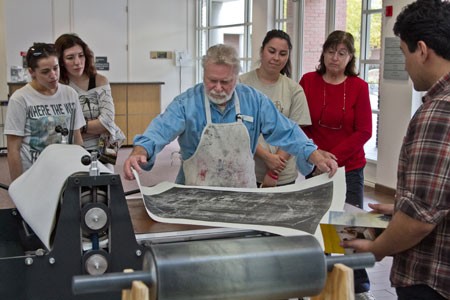Solar printmaker catches spring rays
The residency of artist Dan Welden continues through March 7 at the Kwan Fong Gallery.

Welden donated a Solarplate print run titled "The Gift" to the Art Department.
Photo: Brian Stethem"I don't
like to teach everybody the same thing. I like to find out where they're strong
and develop that strength," says Dan Welden, as he inks a steel-backed plate
for printing inside of the Kwan Fong Gallery. The gallery served as the Sag
Harbor, N.Y.-based master printmaker's workshop during his residency at CLU
from Jan. 30 to March 7.
On
this afternoon, Welden busies himself unhurriedly, eyes glittering, the way
you'd picture Santa Claus in February. He offers to comb his hair for photos or
to mess it up a bit, saying he's flexible.
In
the 1970s he came up with a novel printmaking method called Solarplate, which
uses sunlight instead of engraving tools to make designs for printing. He's
been using and teaching it worldwide ever since. The principal advantage of the
method, compared with traditional copper plate etching, is that no toxic
chemicals are required to ready the plate for the press.
So
rather than fuss with solvents and the gallery's ventilation, Welden scrubs out
the unexposed portions of the Solarplate's light-sensitive top layer using tap
water. Because of the overcast day, he's left the Solarplate outside to catch
ultraviolet rays for a full minute instead of 30 seconds, which is nearer to
the norm in Thousand Oaks.
A
less obvious advantage of Welden's printmaking method is that it allows him to
follow his teaching philosophy of focusing on an artist's strengths. As Jason
Nguyen '11 points out, a Solarplate artist begins his or her process by
deciding how to produce the transparency that partially covers the
steel-and-photopolymer plate. You could start with a drawing, a photograph or a
piece of digital artwork rendered on mylar. This opens up fine art printmaking
to all sorts of visual artists.
For his own works in the mode of abstract expressionism,
Welden makes drawings on transparencies using his fingers and other tools. On
this day, he tells the students and local artists assembled in the gallery that
he started off with "some garbage."
In
time, Welden will ink the Solarplate for a relief print (showing the raised
surfaces) and wipe it off for an intaglio print (showing the grooves). The plate
goes under a roller press along with a broad sheet of damp paper, the
high-quality kind made from discarded rags.
"This
is the beginning of a piece as opposed to the end," explains Welden after
pulling the print. "I use the print many times as a point of departure" for
further drawing and painting.
Nguyen first learned these techniques from Welden as an art
major, at a workshop organized by CLU printmaking instructor Kristi Colell.
"I
ended up making a lot of work just because it was so quick and so easy," he
said.
Later,
Colell and Nguyen both taught alongside Welden in Florence, Italy, and Nguyen worked as his assistant again this spring during
the six-week residency.
Two
intensive printmaking workshops taught by Welden in February helped to pay for the days and hours that he dedicated to Colell's
current students. Several of the attendees were local artists who frequently
audit art classes on campus. Welden also donated the proceeds of a 40-print run
to the department.
Today's
students, according to Welden, relish the idea of making art with their hands
because they spend so much time at computers.
"They
used their hands before they used the computer, and then they got into the
computer and they forgot about their hands. I'm very much one to bring back
what's inherent to human beings," he said.
CLU's Artists and Speakers Committee and the Art Department
sponsored the master printmaker's residency.